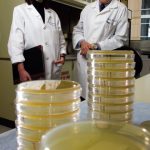Identifying New Treatment Combinations in Lung Cancer
Read moreType: Translational
Facilitate the transition of projects from the laboratory to the clinic. Translational researchers seek to apply basic knowledge of cancer and bring the benefits of the new basic-level understandings to patients more quickly and efficiently. These grants are $600,000, three-year commitments
Ronald A. DePinho, M.D., Elizabeth Anne Maher, M.D., Ph.D.
In honor of ESPN, Inc.
Wadih Arap, M.D., Ph.D., Renata Pasqualini, Ph.D.
Greg Otterson, M.D., Christoph Plass, Ph.D., Ming You, M.D., Ph.D.
James M. Ford, M.D., Sylvia Plevritis, Ph.D.
Funded by The V Foundation Wine Celebration
In honor of Joan and Koerner Rombauer
Jun Yang, Ph.D.
Linzhao Cheng, Ph.D., Hyam I. Levitsky, M.D., Martin G. Pomper, M.D. , Ph.D. Richard Wahl, M.D.
Scott Antonia, M.D., Ph.D., Amer Berg, Ph.D., Dung-Tsa Chen, Ph.D.
Adenocarcinoma is the most common type of lung cancer, and the majority of people diagnosed with this disease will die from metastases. Chemotherapy is the standard way to treat this cancer, and this provides clear benefits including increasing the lifespan of patients. However this benefit is limited and all patients eventually become resistant to standard therapy. Therefore new types of treatment need to be developed. Immunotherapy is a type of treatment designed to get a patient’s own immune system to kill their cancer. Very recently it was demonstrated that an immunotherapy called anti-PD1 has surprisingly good activity in lung cancer. Rapid and prolonged regressions of tumors occur in about one quarter of patients. Now it is important to develop combination therapies with this agent that may help the three quarters of patients who do not respond to anti-PD1. One such approach would be to combine anti-PD1 with a therapeutic cancer vaccine. Vaccines are designed to increase the number of lymphocytes in patients that can recognize and kill cancer cells. Many of these sorts of vaccines have been developed that are very effective in accomplishing this lymphocyte expansion, but none have been very good at killing tumors. One reason for this is that tumor cells can produce a protein called PD-L1 that binds to PD1, another protein on the surface of the lymphocytes activated by the vaccines, which shuts down their ability to kill cancer cells. Anti-PD1 prevents this from happening. We propose to combine anti-PD1 with a cancer vaccine for the first time to treat patients with advanced stage lung adenocarcinoma. We will use a vaccine that activates lymphocytes that recognize a protein called mesothelin which is produced by many lung adenocarcinomas and has been shown previously to expand the number of mesothelin-specific lymphocytes in cancer patients. We expect that combining this vaccine with anti-PD1 will be synergistic, producing improved clinical outcomes. We will also comprehensively analyze the immune systems of the patients and characteristics of their tumors which may be responsible for producing resistance to anti-PD1 and/ or the vaccine. This information can then be used to suggest additional agents that can be added to the anti-PD1/ vaccine combination in the future to further improve the effectiveness of this therapy.
Amar Gajjar, M.D., Richard J. Gilbertson, M.D., Ph.D., Helen Poppleton, Ph.D.
Nabeel Bardeesy, Ph.D., Cyril Benes, Ph.D., Andrew Zhu, M.D., Ph.D.
Cancers that emerge from bile ducts and other part of the biliary tract are exceedingly difficult to treat. The subset of these tumors that are arise within the liver are called intrahepatic cholangiocarcinomas, which represent the second most common type of liver tumor. Unfortunately, the incidence of these cancers has risen worldwide for the past 3 decades. An estimated 80,000 patients die from this disease annually, although the actual rate is likely several times higher, as recent studies demonstrate that many tumors previously designated as “cancers of unknown origin” are in fact cholangiocarcinomas. In most cases, intrahepatic cholangiocarciniomas are diagnosed at advanced stage and have a poor prognosis. Despite the current standard chemotherapy with gemcitabine/cisplatin combination for patients with unresectable or metastatic biliary tract cancer, the median survival time remains less than one year. There are no standard treatments for patients who failed gemcitabine/platinum-based chemotherapy, and overall this remains among the most lethal of human cancers. Therefore, there is clearly an urgent need to identify better drugs against cholangiocarcinomas and to improve treatment of patients affected with this cancer today.
Our group has shown previously that mutations in two genes known to cause brain tumors and leukemias are also commonly found in intrahepatic cholangiocarcinoma. These genes, Isocitrate Dehydrogenase 1 and 2 (IDH1 and IDH2) are mutated in about 25% of intrahepatic cholangiocarcinomas. Our recent laboratory studies have shown that these mutations can convert mature specialized liver cells into a less differentiated (i.e. more primitive) state, raising the possibility that they might make them differentially sensitive to some targeted drugs.
To identify such drugs, we tested more than 1000 cell lines derived from many types of cancer including more than 20 bile duct cancers in large scale screens using several hundreds drugs. These studies identified that a type of drug (in the class of kinase inhibitors) already approved to treat another type of cancer is very efficient at killing IDH mutated intrahepatic cholangiocarcinoma cells compared to virtually all the other cells tested. This kinase inhibitor has been used in large number of patients already and much is known about the doses to use and its potential side effects. Our additional laboratory results suggest that the doses used in other cancers will be efficient to treat patients with IDH mutated intrahepatic cholangiocarcinomas.
We propose to initiate a clinical trial to evaluate the safety and efficacy is this drug in intrahepatic cholangiocarcinoma patients. Our proposal includes a parallel evaluation of responses in mice engineered to develop intrahepatic cholangiocarcinoma with IDH mutations and additional mutations that we believe might influence how well patient will respond. With these studies we will better understand how to treat different patients with IDH mutations. In addition, we propose to use cells derived from individual patients to identify potential mechanisms of resistance and drug combinations that might further improve treatment success.
In conclusion, we have identified a new exciting opportunity to treat patients with intrahepatic cholangiocarcinoma using an already approved drug in use in other cancers. We can readily identify patients that should be treated with this kinase inhibiting drug and we have a number of follow-up studies ongoing in the laboratory that will inform the results of the clinical trial proposed and further developed better ways to treat this cancer. We believe that we have a great opportunity to improve the care of a number of patients affected by biliary tract cancer today.













